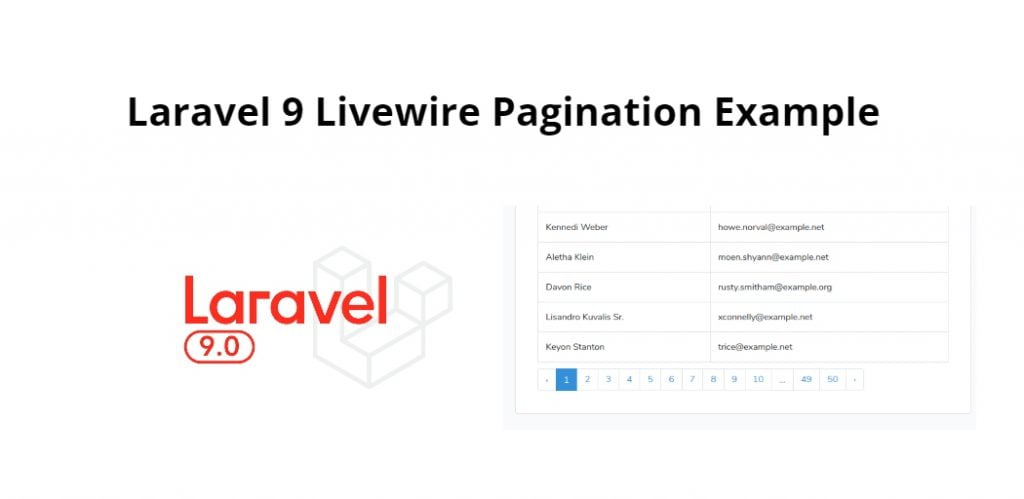Laravel 9 livewire pagination; In this tutorial, we will learn how to create laravel livewire pagination app using the default laravel pagination method with livewire components.
Note that, In this laravel livewire pagination, we will use default laravel pagination method to create pagination app using livewire in laravel.
Laravel 9 Livewire Pagination Example
Follow the following steps to create laravel 9 livewire pagination app:
- Step 1: Download Laravel App
- Step 2: Add Database Detail
- Step 3: Create Model & Migration using Artisan
- Step 4: Install Livewire Package
- Step 5: Create a Pagination Component using Artisan
- Step 6: Add Route
- Step 7: Create View File
- Step 8: Run Development Server
Step 1: Download Laravel App
First of all, Open terminal OR command prompt and run the following command to install laravel fresh app to create laravel livewire pagination app:
composer create-project --prefer-dist laravel/laravel blog
Step 2: Add Database Detail
In this step, Add database credentials in the .env file. So open project root directory and find .env file. Then add database detail in .env file:
DB_CONNECTION=mysql DB_HOST=127.0.0.1 DB_PORT=3306 DB_DATABASE=here database name here DB_USERNAME=here database username here DB_PASSWORD=here database password here
Step 3: Run Migration
In this step, generate model, migration and faker file using the following command:
php artisan make:model Employee -fm
This command will create one model name Employee.php,create one migration that name create_employees_table.php and one faker file that name EmployeeFactory.php .
So, Navigate to database/migrations folder and open create_ employees_table.php file. Then update the following code into create_ employees_table.php file:
<?php
use Illuminate\Database\Migrations\Migration;
use Illuminate\Database\Schema\Blueprint;
use Illuminate\Support\Facades\Schema;
class CreateEmployeesTable extends Migration
{
/**
* Run the migrations.
*
* @return void
*/
public function up()
{
Schema::create('employees', function (Blueprint $table) {
$table->bigIncrements('id');
$table->string('name');
$table->string('email');
$table->timestamps();
});
}
/**
* Reverse the migrations.
*
* @return void
*/
public function down()
{
Schema::dropIfExists('employees');
}
}
Next, open command prompt and run the following command to create the table into database:
php artisan migrate
Next, Navigate to app/Models/Employee.php and update the following code into Employee.php model as follow:
<?php
namespace App\Models;
use Illuminate\Database\Eloquent\Model;
class Employee extends Model
{
protected $guarded = [];
}
Next, Navigate to database/factories and open EmployeeFactory.php. Then update the following code into it as follow:
<?php
use Faker\Generator as Faker;
$factory->define(App\Models\Employee::class, function (Faker $faker) {
return [
'name' => $faker->name,
'email' => $faker->unique()->safeEmail
];
});
After that, run the following command to generate fake data using faker as follow:
php artisan tinker //and then factory(\App\Models\Employee::class,50)->create() exit
Step 4: Install Livewire Package
In this step, we need to install livewire package to laravel project using the following command:
composer require livewire/livewire
Step 5: Create Component using Artisan
In this step, create the livewire components for creating a laravel livewire pagination component using the following command. So Open cmd and run the following command:
php artisan make:livewire pagination
This command will create the following components on the following path:
app/Http/Livewire/Pagination.php resources/views/livewire/pagination.blade.php
Now, Navigate to app/Http/Livewire folder and open Pagination.php file. Then add the following code into Pagination.php file:
<?php
namespace App\Http\Livewire;
use Livewire\Component;
use App\Models\Employee;
class Pagination extends Component
{
public function render()
{
$employees = Employee::latest()->paginate(10);
return view('livewire.pagination',['employees' => $employees]);
}
}
After that, Navigate to resources/views/livewire folder and open pagination.blade.php file. Then add the following code into pagination.blade.php file:
<div>
<div class="table-responsive">
<table class="table table-bordered">
<thead>
<tr>
<th>No.</th>
<th>Name</th>
<th>Email</th>
</tr>
</thead>
<tbody>
@foreach($employees as $em)
<tr>
<td>{{ $em->id }}</td>
<td>{{ $em->name }}</td>
<td>{{ $em->email }}</td>
</tr>
@endforeach
</tbody>
</table>
{{ $employees->links() }}
</div>
</div>
Step 6: Add Route
In this step, Navigate to routes folder and open web.php. Then add the following routes into web.php file:
Route::get('/livewire-pagination', function () {
return view('livewire.home');
});
Step 7: Create View File
In this step, navigate to resources/views/livewire folder and create one blade view files that name home.blade.php file. Then add the following code into home.blade.php file:
<!DOCTYPE html>
<html lang="{{ str_replace('_', '-', app()->getLocale()) }}">
<head>
<meta charset="utf-8">
<meta name="viewport" content="width=device-width, initial-scale=1">
<title>Laravel 9 Livewire Pagination - Tutsmake.com</title>
<!-- Fonts -->
<link href="https://fonts.googleapis.com/css?family=Nunito:200,600" rel="stylesheet">
<link rel="stylesheet" href="https://stackpath.bootstrapcdn.com/bootstrap/4.5.1/css/bootstrap.min.css">
<!-- Styles -->
<style>
html, body {
background-color: #fff;
color: #636b6f;
font-family: 'Nunito', sans-serif;
font-weight: 200;
height: 100vh;
margin: 0;
}
.full-height {
height: 100vh;
}
.flex-center {
align-items: center;
display: flex;
justify-content: center;
}
.position-ref {
position: relative;
}
.top-right {
position: absolute;
right: 10px;
top: 18px;
}
.content {
text-align: center;
}
.title {
font-size: 84px;
}
.links > a {
color: #636b6f;
padding: 0 25px;
font-size: 13px;
font-weight: 600;
letter-spacing: .1rem;
text-decoration: none;
text-transform: uppercase;
}
.m-b-md {
margin-bottom: 30px;
}
</style>
</head>
<body>
<div class="container mt-5">
<div class="row mt-5 justify-content-center">
<div class="mt-5 col-md-8">
<div class="card">
<div class="card-header bg-primary">
<h2 class="text-white">Laravel Livewire Pagination - Tutsmake.com</h2>
</div>
<div class="card-body">
@livewire('pagination')
</div>
</div>
</div>
</div>
</div>
@livewireScripts
</body>
</html>
Step 8: Run Development Server
Finally, we need to run the following PHP artisan serve command to start laravel livewire pagination example app:
php artisan serve If we want to run the project diffrent port so use this below command php artisan serve --port=8080
Now, we are ready to run laravel livewire pagination app. So open browser and hit the following URL into browser:
http://localhost:8000/livewire-pagination
